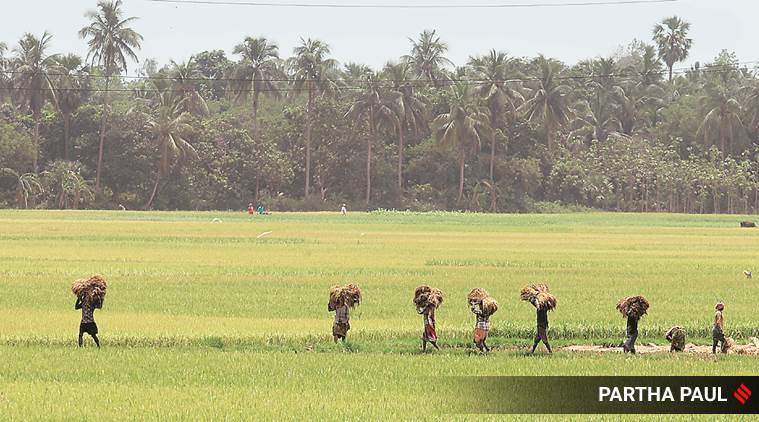 Lockdown, lack of cheap migrant labour mean harvest has spilled over from April. (Express Photo: Partha Paul)
Lockdown, lack of cheap migrant labour mean harvest has spilled over from April. (Express Photo: Partha Paul)
Yadav Ghorui has rarely been this busy during harvest season. He is one of eight farm labourers called in to work on a one-bigha field in his Ajapur village in Burdwan, about 100 km from Kolkata.
“Last year, I got Rs 200 and 2 kg of rice every day that I worked; this year I am getting Rs 350 and 2 kg rice. Our group of eight is booked for the entire month. Work began a week ago and we have to harvest, bundle the paddy and dehusk the grains in two days. We work at night too,” said Ghorui, who lives with his wife and two children.
The rabi crop, known as Boro Dhan in Bengal, is sown in November and usually harvested by April. But this year, the lockdown has delayed the harvest by over a month, and now, farmers are racing against time to finish before the rains at the end of June.
The lockdown has also meant farm owners haven’t been able to bring in cheaper migrant workers from states such as Bihar and Jharkhand, or from Birbhum, Bankura and Purulia districts in the state. While the state government has allowed combine harvesting machines to move, most of the operators of these machines are from Punjab and Haryana. So, cultivators and owners have had to depend on local hands, thus pushing up demand and daily wages.
Ghorui’s co-worker, Sandhya Malik, her face and head covered with a cloth, said, “Within a couple of weeks of the lockdown, we had exhausted all cash. But all that has changed. Now I can buy anything for the family — biscuits, milk and vegetables. God has been kind.”
Pradip Majumder, the advisor on agriculture to Chief Minister Mamata Banerjee, said harvesting of paddy was happening on a “war footing”, with social distancing norms in place.
“Out of over 3,000 harvester machines in the state, around 800 have chain wheels (which work better in fields rendered wet after the rains). They are on their way to the fields,” said Majumder.
The sporadic rains since last week have added to the farmers’ worries. “If there is more water, the paddy will germinate in the field and will be useless. If the grains have moisture content less than 12%, they can be stored. But anything more than 15% will mean pest infestation. And if the moisture content is over 20%, the rice will have to be discarded,” said Jagannath Chatterjee, Deputy Director, Agriculture, Purba Burdwan.
This year, paddy has been cultivated on 1.7 lakh hectares in the district, up from 1.2 lakh hectares last year.
About 60 km from Ajapur, in Dharampur village, Sheikh Ashraf, 35, who owns 16 bighas, has only been able to harvest nine using machines, and is unsure if he can finish before the rains. His input costs have also gone up, he adds, listing how harvester machines are charging Rs 2,500 to 3,000 per hour, those with chain wheels around Rs 4,000 an hour, and the rise in wages from Rs 220 to Rs 360.
On the road behind him, labourers use their feet to spread paddy grains on the tarmac. “Since there’s hardly any traffic, we leave the grain here to dry,” said Ashraf.
About 50 feet away, Kalyan Mondol stood by the harvester machine he owns, along with his driver Abesh Malas. They are here from neighbouring Bankura district; a month ago, they were in Murshidabad.
“I usually get the drivers from Punjab or Haryana. Now our boys here have learnt to operate the machine. I pay Abesh about Rs 900 a day. I have two drivers here, they take turns to operate the machine. I keep getting calls from farmers asking for the harvester,” said Mondol, adding that his machine can lift paddy from 2.5 to 3 bighas of land in one hour.
In neighbouring Eroar village, Mangobindo Adhikari, panchayat member and local Trinamool leader, said more is needed to generate employment. “There was some talk of including harvesting under the MNREGS, but it has not been done yet,” he said.
In Golsi village, Sheikh Ajijur Rehman, 50, is waiting for the harvester to reach his 30-bigha land. On fields nearby, chain-wheel harvester machines can be seen cutting, de-husking and then emptying the grains into mini-vans along the road.
“Two days ago, I tried to get 12 labourers from Jharkhand, but police stopped them at the border near Dubrajpur (Birbhum district). The government is allowing labourers from other districts, but arranging transport for them is expensive,” said Ajijur.
He said he was 15th in the queue for a harvester. “It will be around midnight when my turn comes,” he said.